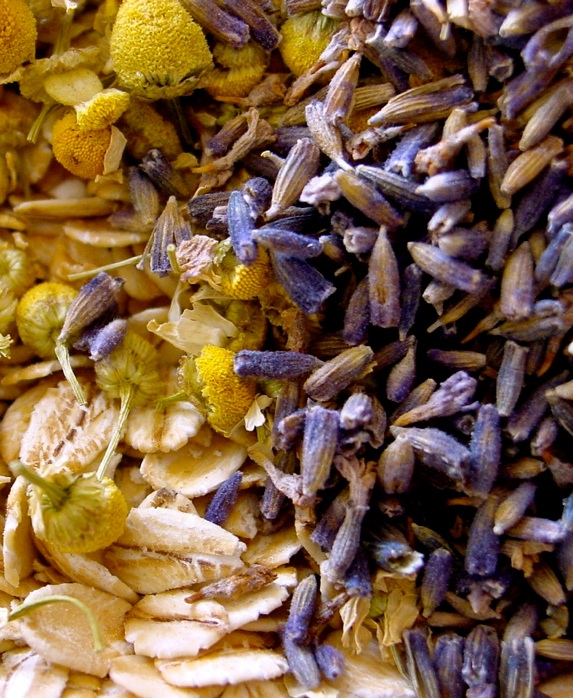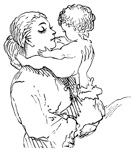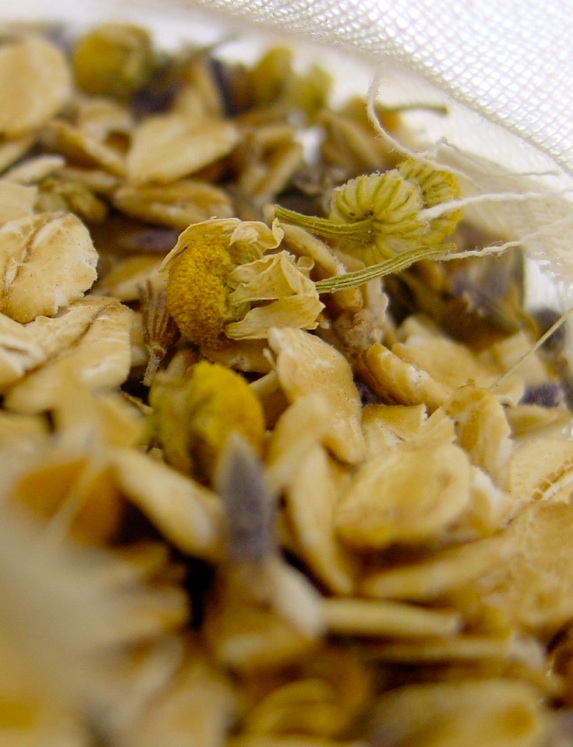




How but in custom and ceremony
Are Innocence and Beauty Born?
—William Butler Yeats
Natural Treatment of Diaper Rash
Monday, October 1, 2012

What Is Diaper Rash?—Diaper rash, or irritant diaper dermatitis, is a generic name for painful irritation of the skin in the diaper area. When the skin is exposed to prolonged wetness, or there is an increase in skin pH (as by exposure to urine and feces), the outermost layer of the skin begins to break down. There is generally a red, splotchy rash that may blister and bleed in more severe cases. There is also a chance of secondary infection by bacteria and fungi. Other causes of skin irritation in the diaper area are tight diapers or allergic reactions.
The “Diaper” in “Diaper Rash”—Diaper rash has been accepted as “a normal part of being a baby,” (Dr. William Sears) but it was a condition far less noted before disposable diapers. An article published in the Journal of Pediatrics in 1959 (before the introduction of disposable diapers) noted a 7.1% rate of diaper rash in a one-time clinical study of 1,505 babies. Twenty years after disposable diapers were introduced, the rates had risen to 63% of 1,050 babies experiencing diaper rash sometime in an eight-week period. What is it about disposable diapers that makes the difference?
The manufacturers are very reticent about their material lists, but disposable diapers can be expected to include polyethylene, polypropylene plastic, bleach paper pulp, dioxin, polyacrylate gel, petrolatum, stearyl alcohol, cellulose tissue, elastic, and synthetic perfume. Research on these ingredients reveals a litany of health problems, and diaper rash is only the most familiar and benign. Toxic emissions from disposable diapers have been strongly implicated in the rise of childhood asthma. In little boys, these diapers can cause a rise in scrotal temperature that will later effect fertility. Some of the ingredients in disposable diapers are the same that have been shown to cause toxic shock syndrome in tampons. Others have been shown to cause reproductive and developmental problems, reduced immunity, hormone imbalance, and even cancer.
Disposable diapers manufactured today are super-absorbent; and often neither the caregiver nor the child is aware of the need for changing until the diaper is saturated after several wettings. Meanwhile, the child is encased in a heated, airless environment where ammonia in the urine reacts with diaper chemicals to create new toxic compounds.
Natural Prevention for General Diaper Rash

-
✦Breastfed babies have a much lower incidence of diaper rash, perhaps in part because their stools have a higher pH and lower enzymatic activity. Breast-milk also affords babies protection from food allergies that may cause or exacerbate diaper rash, while baby formula appears to predispose babies to food allergies and may even be allergenic itself.
-
✦A higher incidence of diaper rash occurs in infants aged 8 to 12 months, a time when many are increasing their intake of solid foods. Avoid introducing allergenic foods—especially grains and dairy—to your baby’s diet too soon. Any significant change in the baby’s diet will increase susceptibility to diaper rash, because of changes in fecal composition. I recommend for further reading the KellyMom website, which has valuable, evidence-based information on food introduction. [http://kellymom.com]
-
✦Consider the ancient multicultural practice known popularly in the West as Natural Infant Hygiene, or Elimination Communication (EC). Babies are born with awareness of their elimination needs, and can learn with the loving assistance of their caregivers to communicate those needs with vocal and physical cues. The method eliminates or reduces the need for diapering, which reduces the chance of diaper rash by increasing air circulation and decreasing irritating contact. I recommend for further reading the website of the non-profit organization DiaperFreeBaby [http://www.diaperfreebaby.org] or Ingrid Bauer’s book Diaper Free: The Gentle Wisdom of Natural Infant Hygiene.
-
✦Consider cloth diapering. Forget dangerous pins and plain cotton squares—today’s cloth diapers are cute and convenient with easy snaps, contour, and colorful patterns. Not only will cloth diapering reduce your baby’s toxic load, but you will save money in the long-run. (Consider that laundry detergent can also contribute to skin irritations; launder cloth diapers with a small amount of natural, hypoallergenic detergent and plenty of hot water.) I recommend for further reading the website of the non-profit organization Real Diaper Association [http://www.realdiaperassociation.org].
-
✦Consider using homemade wipes that do not contain the irritating detergents and synthetic fragrances of conventional wipes. Simply wet paper towels or flannel cloths with water as needed for cleaning the baby during a diaper change. You can also use this basic recipe for pre-wetted wipes.
Homemade Wipes—In a jar mix 2 tablespoons unscented baby castile wash, 2 tablespoons olive oil, and 2 cups of distilled water. Pour the solution over your contained wipes (enough for several days), and store extra in the refrigerator.
-
✦Consider choosing disposable diapers and wipes that are hypo-allergenic and made of natural materials, such as those by Broody Chick Natural Products [http://www.broodychick.com]. (Check material labels, as many “natural” diapers contain the same toxic chemicals you are trying to avoid.) These diapers will not be the super-absorbent variety that withstands several wettings; the need for diaper changes will be more readily apparent, which helps prevent diaper rash. Unfortunately, these diapers tend to be more expensive; some parents choose to offset costs by cloth diapering at home and using the natural disposables when visiting or traveling.
-
✦Regardless of whether you use EC, cloth diapers, disposable diapers, or a combination of these, it is important to skin health that the baby’s bottom receive adequate exposure to air and sunshine. A possible routine is a daytime bath (with a gentle unscented soap) followed by at least twenty minutes of “naked time”—perhaps including a baby massage.
-
✦Change diapers frequently. Especially if you are using super-absorbent diapers, it is important to check the diaper often, as the baby may not feel wet and signal the need for a change. Change the diaper before it feels “mushy”—after it has lost its thin, board-like quality. Certainly, change the diaper as soon as possible after every bowel movement.
-
✦Many use baby powder to help keep the diaper area dry, but synthetic perfume and other chemicals may be irritating to the baby’s sensitive skin. If purchasing a baby-powder, choose an unscented powder free of talc. (Talc is a mineral that often contains micro-fibers very similar to cancer-causing asbestos. Even in the absence of these asbestos-like fibers, talc has been implicated in cases of lung and ovarian cancers.) Baby powders are unnecessary, but if you wish to use them, consider plain cornstarch or the following recipe from the book Organic Body Care Recipes by Stephanie Tourles.
Baby Powder—In a food processor blend together 1 1/2 cup arrowroot powder, 1/2 cup baking soda, 1/2 cup finely powdered herb (calendula, chamomile, or elder flowers), 1/2 cup rice flour or cornstarch, and 20 drops of essential oil (Roman chamomile, lavender, or sweet orange) added drop by drop. Store in a dispenser as long as a year. Note: Inhalation of powder is irritating to the respiratory system. Shake the powder into your hand away from baby’s face before carefully applying it to his bottom.
Natural Intervention for General Diaper Rash
Even if your baby is already experiencing diaper rash, the preventative measures discussed above are an important consideration in natural home intervention. For instance, you may find it helpful to change your diapering method.
-
✦Avoid wiping a painful diaper rash. Gently and thoroughly rinse the baby’s bottom with warm water, blot dry, and allow skin to air-dry completely before re-diapering.
-
✦Bathe gently in warm water that is steeped in oatmeal and lavender or chamomile herb (or a few drops of lavender or chamomile essential oil). Blot the baby’s bottom dry and allow to airy-dry completely before re-diapering.
Berceuse Bath Blend—Berceuse means “lullaby.” Blend together three parts rolled oatmeal (not the instant variety), one part whole chamomile flowers, and one part lavender. Store in a tightly sealed container as long as a year. To use, spoon desired amount into a small muslin bag that ties shut. Allow the water to run through the bag as you fill the tub, then drop the sachet into the water. Bathe at least thirty minutes for medicinal effect.
-
✦Use generous amounts of a natural diaper ointment. You can purchase a preparation such as Baby Bee™ Diaper Ointment by Burt’s Bees® [http://www.burtsbees.com] or Baby Balm by Mountain Rose Herbs® [http://www.mountainroseherbs.com]; or consider the following basic recipes for salves to make at home ahead of time.
Basic Diaper Salve—In a small bowl with a hand-mixer, blend together 1/8 cup extra-virgin coconut oil, 1/4 cup raw shea butter, and enough arrowroot powder (4-5 tablespoons) to achieve desired thickness. Store salve in a covered container as long as a year. (For additional soothing quality, infuse the coconut oil with calendula and chamomile flowers over a double-boiler, and strain the oil before cooling and blending with other ingredients.)
Herbal Diaper Salve—The herbs in this recipe have healing and soothing properties. 1 part St. John’s wort, 2 parts calendula flower, 1 part comfrey leaf, 1 part comfrey root, 1 part plantain leaf. Cover the herbs with oil (jojoba, grapeseed or olive) and keep at low heat in a crock-pot or double boiler for at least 5 hours. After straining the oil, blend it with beeswax in a double-boiler. Prick a capsule of Vitamin E and squeeze out its contents into the salve, along with a few drops of lavender essential oil. Pour the salve into clean containers and allow to cool before covering and storing as long as a year.

Identifying and Treating Diaper Rashes
There are physical characteristics that will help you determine what type of diaper rash your baby has. Actually, the first two or three listed here might be considered “true” diaper rashes, while eczema and seborrheic dermatitis are systemic conditions that may manifest as a “rash” in the diaper area. Although the recommendations listed above apply to “diaper rashes” of multiple causes, the following will help you decide what specialized measures you can take to treat your baby.
Contact Diaper Rash—A contact diaper rash is the “simple diaper rash” caused by prolonged contact with irritating substances such as urine, feces, or diaper chemicals. A contact diaper rash is indicated by flat, red, irritated skin. There may be peeling of the skin or blistering in more severe cases.
-
Natural Prevention and Intervention
-
✦See the recommendations listed above for “General Diaper Rash.”
Intertrigo Rash (Tidemark Dermatitis)—These fancy names indicate skin irritation caused by painful chafing from tight diapers or binding. The chafed area has a red, burn-like appearance.
-
Natural Prevention and Intervention
-
In addition to considering the recommendations listed above for “General Diaper Rash”—
-
✦Secure diapers less tightly.
-
✦Sooth and protect burned areas with thick layer of protective ointment.
Yeast “Diaper Rash” (Candidal Dermatitis)—When the skin is damaged, yeast from the intestines has an opportunity to invade the skin; the warm and moist environment of the diaper provides ideal growing conditions. A yeast infection may occur in either girls or boys, and is especially likely after a prolonged diaper rash, a thrush infection (yeast infection in the mouth), or antibiotic use by the mother or baby. A yeast infection is indicated by a red, raised, patchy, well-defined rash that occurs mostly over the genitalia with satellite spots sprinkled over the diaper area. The skin may also be scaly.
-
Natural Prevention and Intervention
(Note: If the infection does not improve within three days of treatment, or if the child develops a fever, open sores, or oozing yellow patches, contact your healthcare provider to determine whether there is a bacterial infection requiring antibiotic treatment.) -
In addition to considering the recommendations listed above for “General Diaper Rash”—
-
✦Treat diaper rashes promptly.
-
✦Avoid antibiotic use in baby or mother unless medically necessary. Research foods and herbs that have antibacterial action—particularly garlic. I recommend for further reading Herbal Antibiotics by Stephen Harrod Buhner.
-
✦Regular diaper ointments will not have effect against a yeast infection; choose an anti-yeast or anti-fungal ointment, such as acidophilus paste or gentian violet.
-
✦You can make your own anti-fungal diaper wipes using this recipe from Morgan Botanicals.—In a jar mix mix 1 cup distilled water, 1 tablespoon vinegar, 1-2 cups of aloe vera gel, 1 tablespoon oil infused with calendula, 2 drops lavender essential oil, and 3 drops tea tree essential oil. Pour the solution over your contained wipes (enough for several days), and store extra in the refrigerator.
-
✦Do not use cornstarch or baby powders containing cornstarch, as it will feed the yeast organisms and exacerbate the infection.
-
✦If your baby is eating solids, eliminate or avoid dairy and simple carbohydrates (especially sugar and refined grain) from the diet. If you are breastfeeding, eliminate or avoid these foods in your own diet.
-
✦Include acidophilus in your baby’s diet to help restore a healthy gut flora balance. If the baby is eating solid foods, include those high in acidophilus (yogurt, carrot, banana, garbanzo beans), or supplement with a daily teaspoon of acidophilus powder an hour before eating.
-
✦Yeast bacteria can live up to five days on baby’s skin and clothes, even after the rash has cleared. Avoid a recurrence by disinfecting baby’s cloth diapers, clothing, and sheets with a natural, non-irritant disinfectant like apple cider vinegar.
High-quality raw honey shows promise as a clinical treatment for even the severest diaper rashes. A medical nurse working in a missionary hospital in 1979 witnessed an influx of migrant children who stayed in the same diaper for 16 hours or longer while their parents worked in the fields. ”[C]onsequently, they had horrendous, often excoriated buttocks (lots of yeast, strep, and staph). I had two different treatments for them that healed them—in a word—overnight… [One] method was just applying raw honey [then using a light bulb positioned 18”-24” away] for drying/ healing.” Source: [http://www.henriettesherbal.com/archives/best/2003/diaper-rash.html]

Atopic Dermatitis (Eczema) and Seborrheic Dermatitis—Eczema and seborrheic dermatitis are inflammatory, itchy skin conditions associated with food allergies. They can effect the skin on any part of the body, but may appear on babies only in the diaper area because of the additional irritation of chafing, warmth, moisture, and chemicals. Eczema is indicated by dry, irritated skin that may ooze and crust over. Seborrheic dermatitis appears as a large, red, well-defined patch over the groin, genitalia, and lower abdomen. It may be raised, rough, thick, and greasy.
-
Natural Prevention and Intervention
In addition to considering the recommendations listed above for “General Diaper Rash,” research eczema and seborrheic dermatitis for information about the systemic treatment of these conditions. -
✦Discontinue suspected foods.
-
✦A deficiency of essential fatty acids decreases immune function and may lead to allergies and allergy-related conditions. If the baby is eating solid foods, include those high in essential fatty acids (avocado, dark green vegetables, deep-water fish, flaxseed, coconut oil, legumes). If you are breastfeeding, increase your own dietary intake of essential fatty acids or supplement with 6-8 grams daily of evening primrose oil. ❖
Samantha A. Little is not a medical doctor, nor is she a licensed medical professional. Any recommendations are to educate for consumer health awareness and should not be considered diagnosis or prescribed treatment for any medical condition. If your baby is experiencing symptoms that concern you, please consult your healthcare provider.
History
October 1, 2012 Originally published as “Natural Treatment of Diaper Rash” on the blog Linnet on the Leaf.
© Copyright
Samantha Little holds the copyright for the article “Diaper Rash” and other content of this site. Readers are welcome to print this page for personal reference only, or to share the URL with others. Please do not reprint or modify this article without written permission from the author. Thank you for your integrity.


